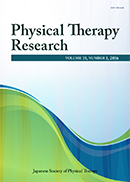Virtual issue
Volume 23, Issue 1
Displaying 1-15 of 15 articles from this issue
- |<
- <
- 1
- >
- >|
Review
-
2020Volume 23Issue 1 Pages 1-7
Published: June 20, 2020
Released on J-STAGE: June 20, 2020
Download PDF (78K) -
2020Volume 23Issue 1 Pages 8-14
Published: June 20, 2020
Released on J-STAGE: June 20, 2020
Download PDF (303K)
Scientific Research Article
-
2020Volume 23Issue 1 Pages 15-22
Published: June 20, 2020
Released on J-STAGE: June 20, 2020
Advance online publication: October 10, 2019Download PDF (98K) -
2020Volume 23Issue 1 Pages 23-30
Published: June 20, 2020
Released on J-STAGE: June 20, 2020
Advance online publication: March 25, 2020Download PDF (96K) -
2020Volume 23Issue 1 Pages 31-38
Published: June 20, 2020
Released on J-STAGE: June 20, 2020
Advance online publication: February 25, 2020Download PDF (123K) -
2020Volume 23Issue 1 Pages 39-46
Published: June 20, 2020
Released on J-STAGE: June 20, 2020
Advance online publication: March 25, 2020Download PDF (103K) -
2020Volume 23Issue 1 Pages 47-52
Published: June 20, 2020
Released on J-STAGE: June 20, 2020
Advance online publication: February 25, 2020Download PDF (79K) -
2020Volume 23Issue 1 Pages 53-58
Published: June 20, 2020
Released on J-STAGE: June 20, 2020
Advance online publication: March 12, 2020Download PDF (90K) -
2020Volume 23Issue 1 Pages 59-65
Published: June 20, 2020
Released on J-STAGE: June 20, 2020
Advance online publication: February 25, 2020Download PDF (103K) -
2020Volume 23Issue 1 Pages 66-71
Published: June 20, 2020
Released on J-STAGE: June 20, 2020
Advance online publication: February 25, 2020Download PDF (168K) -
2020Volume 23Issue 1 Pages 72-78
Published: June 20, 2020
Released on J-STAGE: June 20, 2020
Advance online publication: March 25, 2020Download PDF (276K) -
2020Volume 23Issue 1 Pages 79-86
Published: June 20, 2020
Released on J-STAGE: June 20, 2020
Advance online publication: March 25, 2020Download PDF (106K)
Case Study
-
2020Volume 23Issue 1 Pages 87-91
Published: June 20, 2020
Released on J-STAGE: June 20, 2020
Advance online publication: February 25, 2020Download PDF (310K)
Brief reports
-
2020Volume 23Issue 1 Pages 92-98
Published: June 20, 2020
Released on J-STAGE: June 20, 2020
Advance online publication: February 25, 2020Download PDF (167K)
Editorial Board
-
2020Volume 23Issue 1 Pages e1
Published: June 20, 2020
Released on J-STAGE: June 20, 2020
Download PDF (29K)
- |<
- <
- 1
- >
- >|
